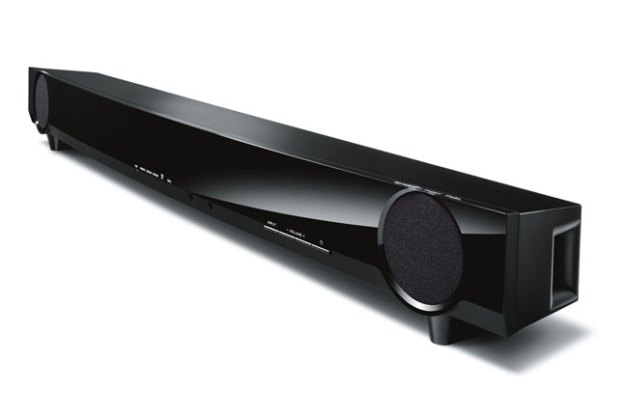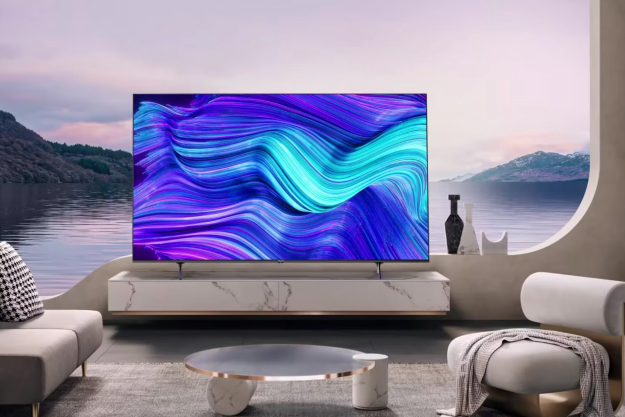
“If Yamaha’s aim was to create a full sounding, self-contained, slim sound bar solution at an accessible price, we’d say they pretty much nailed it on the head with the YAS-101.”
- Substantial low bass for a small enclosure
- Clean, controlled high frequencies
- Univolume keeps loud ads at bay
- One digital optical cable included
- No analog audio input
- Surround mode steals from fidelity
- Mounting screws not included
Update: Yamaha’s YAS-101 is no longer available, but the company has unveiled several new models since 2011, including the new SR-B20A and SR-C20A. Check out all of our sound bar reviews for more options.
It’s been kind of fun to watch the sound bar progress over the last seven years or so. First there were passive sound bars that simply put a couple of speakers into a wide, short enclosure that looked tidy sitting below a flat panel TV. Eventually, digital amplifiers made their way into sound bars, making them a more convenient proposition.
Then, companies like Polk and Yamaha ushered the sound bar movement into an entirely new direction by figuring out how to produce virtual surround sound from a single sound source sitting in the middle of the room. Yamaha’s YSP-1 made some big waves in the audio biz by using a couple of 4.5-inch drivers with, count ‘em, 40 little 1.5-inch drivers set up in an array, throwing sound all over the room.
The YSP-1 made for an impressive demo, but audio enthusiasts cried for more…specifically, bass. In response, companies like Vizio and Boston Acoustics have since decided to bundle wireless subwoofers with their sound bars. Now that they’ve have caught the attention of the public at large, demand for a slim sound bars that can produce bass without a big box sitting off to the side has grown significantly. It doesn’t hurt that TV manufacturers seem bent on making the speakers built into flat-panel TVs worse and worse, either.
But, we digress. The point is that Yamaha has seen a need and is attempting to fill it with the $300 YAS-101. Did Yamaha crack the big-bass-from-a-small-box code well enough to make a satisfying sounding speaker bar?
 Out of the box
Out of the box
The YAS-101 measures 35 x 3-1/2 x 4-1/2 inches (W x H x D) without its feet or spacer brackets. The feet add ¾ inch of height and the wall spacers add just ½ inch. The whole shebang ways a dainty 9.3 lbs. Cabinet material on the top and bottom panel is a fairly flexible plastic with a glossy black finish that will likely mate well with a wide variety of televisions.
In the box with the sound bar is a remote control, batteries for said remote, a mounting template, a short manual and one 3-foot-long digital optical cable. While we give props to Yamaha for tossing in a free optical cable so that folks can get up and running without heading off to the electronics store, we don’t understand why it didn’t decide to include the two commercially available mounting screws needed for putting the sound bar up on the wall. Good grief. Anyway, plan on hitting the hardware store to pick some up if you want to wall mount. The rest of the process should be a piece of cake with the included template and simple key-hole mounts.
Features
The YAS-101 is a far cry from Yamaha’s famed YSP-1 in terms of driver compliment. Built into the left and right side of the enclosure is a 2.5-inch driver which apparently resides in its own sealed cubby. Two 3-inch “subwoofers” are mounted inside the cabinet toward the right side of the enclosure. You can feel them if you place your hands on the grill that lines the bottom of the sound bar. Two ports open up on the opposing ends of the cabinet. We didn’t pry the sound bar open, but we have a gut feeling the bass ports wind around quite a bit in the cabinet to maximize bass output.
The front of the sound bar has four low-profile control buttons and six small LED indicators. Otherwise the front face is very clean.
On the back of the sound bar we found a recessed connection bay that included two digital optical inputs, one digital coaxial input, a “system control” output and a subwoofer output.

There’s even a clever rear-mounted IR flasher, which will read your TV’s remote control code and flash it out the back, just in case the sound bar covers up your TV’s IR eye.
What’s not so clever is the lack of an analog audio input. Either RCA jacks or a ⅛-inch input would have done, but the fact that neither exist on the YAS-101 seems like a pretty major oversight. Most competing sound bars include an analog input for folks that might want to quickly hook up their mobile devices for a quick music solution.
The YAS-101 offers three processing features to enhance the listener’s experience. “UniVolume” levels out volume dynamics and keeps everything at one volume level. For TV, this is a great feature. We’ve all been slap-chopped out of our seats late at night a few times. For movies, UniVolume keeps those explosions toned down so you don’t wake the kids while watching late night flicks. Keep it turned off for music, though.

“Clear Voice” does as its name implies and bumps up the vocal bandwidth to make dialog more intelligible. We found that it worked to a point, but simply preferred the sound with it turned off.
Finally, “AIR SURROUND XTREME” (you’ve gotta use all caps any time the word extreme is involved) is probably the most important processing feature in the YAS-101. This is Yamaha’s simulated surround system which, by Yamaha’s description, recreates 7.1 surround from two speakers. This type of marketing seems a little much. Yes, the sound bar does offer simulated surround, but to insinuate that you are getting anything remotely close to seven distinct channels of surround sound from two small speakers feels misleading to us. So, let’s just acknowledge now that this is a simulated surround system that creates the impression of surround sound. We let you know how effective it was in our performance review.
We have a feeling some may wonder why it is that the sound bar has no HDMI input, so let’s cover that quickly. The reason is that very few TVs offer an HDMI output, whereas it is very common to find an optical digital output. If not optical, there will usually be a coaxial digital output.
Performance
We tested the YAS-101 in our media room where it would see plenty of TV and gaming action, plus a little music for the sake of drilling down to the finer sonic details. We connected it via the provided digital optical cable directly to a PlayStation 3 and, later, an Xbox 360, since our two Sharp LC-42SB45U TVs require a sort of break-out cable for coaxial digital audio output.
The YAS-101 makes a pretty good first impression. Even at the lowest setting, the two built-in 3-inch subwoofers manage to generate some surprisingly low bass at an equally surprising volume level. We moved through a few movie clips and for a good 20 minutes we marveled at the level of bass output the YAS-101 was capable of.

As we continued listening, the initial shock over the big bass began to wear off and we started listening to the sound bar’s bass response from less of a quantitative perspective and more from a qualitative point of view. To drill down to the nitty gritty, we queued up some music tracks we’re sickeningly familiar with and paid close attention.
What we learned is that, yes, the YAS-101 gets down pretty low. We’d say it is working well down to 55Hz, which is on par with some inexpensive outboard subwoofers. The bass wasn’t loose, but it wasn’t musically taught either. It lacked a little bit of the punch we look for in a balanced speaker system but, come on, we’re talking about a sound bar. Taking that into consideration, the YAS-101 did a pretty great job tackling bass on its own.
The two 2.5inch drivers are responsible for everything from 150Hz and above, meaning a good amount of midrange and all of the treble region. We were pretty happy with what they were able to produce. The high frequencies in particular were clean and glassy, without moving into the metallic region where dazzling turns into annoying. Even overblown movie effects came across with just the right amount of zeal, a tough trick to pull off without some dedicated processing.

Midrange seemed just fine for movies and TV, but you could hear the YAS-101’s limitations when listening to music. The lower end of the midrange region and the upper end of the bass region is where a lot of the “meat and potatoes” of sound lives and, even though the subwoofer is rated to play up to 150Hz, we don’t think it is getting up there with as much bravado as it does in the lower region. Likewise, the 2.5-inch drivers may be rated down to 150hz, but we think they might be rolling off a little early. The result is a little bit of a hole in the frequency response that, quite frankly, didn’t surprise us.
It is important to remember that we’re testing a sound bar that will be used for TV and movies some 90 percent of the time. For those uses, the YAS-101 works extremely well. No one ever said this was an audiophile music solution, but we will say that we think this sound bar sounds far better than many pricey desktop audio solutions we’ve heard over the years.
Conclusion
If Yamaha’s aim was to create a full sounding, self-contained, slim sound bar solution at an accessible price, we’d say they pretty much nailed it on the head with the YAS-101. Though not without its limitations, we think this sound bar does more with one box than some solutions do with two and, at $300, we think this will make an attractive add-on for those who demand better sound than their TV can provide on its own, but don’t have much space to give up. For now, the YAS-101 is the one-piece entry level sound bar to beat.
Highs
- Substantial low bass for a small enclosure
- Clean, controlled high frequencies
- Univolume keeps loud ads at bay
- One digital optical cable included
Lows
- No analog audio input
- Surround mode steals from fidelity
- Mounting screws not included
Editors' Recommendations
- The best soundbars of 2024: a sound upgrade for your TV
- Yamaha’s new compact soundbar is small enough to fit on your desk
- Yamaha adds to its roster with two new budget soundbars, the SR-B20A and SR-C20A
- These are the best Sonos deals for Cyber Monday 2019
- Forget the remote: Yamaha offers two new affordable, Alexa-enabled soundbars





